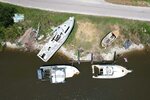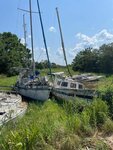The Gulf of Mexico Alliance is poised to execute a $7 million project to remove approximately 100 abandoned vessels and large marine debris located along the Gulf Coast. According to Amanda Nalley, …
This item is available in full to subscribers.
Please log in to continue |



The Gulf of Mexico Alliance is poised to execute a $7 million project to remove approximately 100 abandoned vessels and large marine debris located along the Gulf Coast.
According to Amanda Nalley, communications manager, approximately 45 of the vessels are located within Alabama in both Baldwin and Mobile counties.
Removing these vessels can minimize negative impact to marine habitat as the abandoned vessels and debris can destroy habitat, leak pollutants and pose a navigation hazard to boaters.
"Nearly 100 derelict vessels have already been identified for removal," said Laura Bowie, executive director. "Over the next four years, we'll work with the Mississippi State University Extension Service and state agency partners to remove these vessels. This will improve coastal and marine habitats for the people and wildlife that call the Gulf home."
Per a news release, the organization was formed by the governors of the five states that border the Gulf Coast; Alabama, Florida, Louisiana, Mississippi and Texas. The alliance allows the states to work in collaboration to improve the economic and environmental health of the Gulf and includes over 150 organizations from state and federal agencies, tribal governments, communities, academia, non-governmental organizations and industry within the participating states.
"We have identified some north of I-10, in Gulf Shores and Orange Beach and near Bon Secour River," said Eric Sparks, associate extension professor and director at Mississippi State University, who will be working in conjunction with the alliance to remove the vessels. "I would say they are pretty evenly split between Baldwin County and Mobile."
Additionally, the organization will also remove approximately 20 vessels in Texas and 25 in Mississippi, and a second phase will begin in 2024 to identify and remove additional vessels and debris from along the coast.
Per the release, the project is supported by the National Oceanic and Marine Debris program, which is the federal government's dedicated program for addressing marine debris, and will be funded under the Bipartisan Infrastructure Law.
"The NOAA Marine Debris Program will award up to $24 million through the Bipartisan Infrastructure Law to support the removal of large marine debris throughout the coastal United States, Great Lakes, territories and Freely Associated States," the marine debris program states. "These removal projects should focus on large marine debris, including abandoned and derelict vessels, derelict fishing gear, and other debris that is generally unable to be collected by hand."